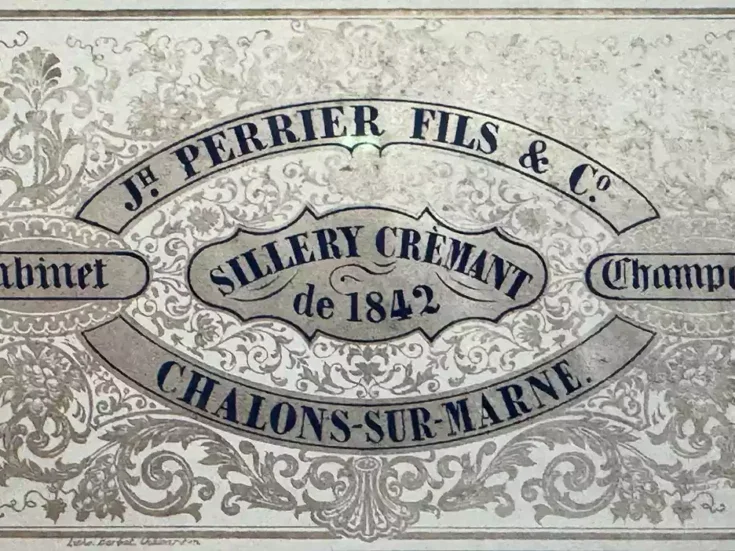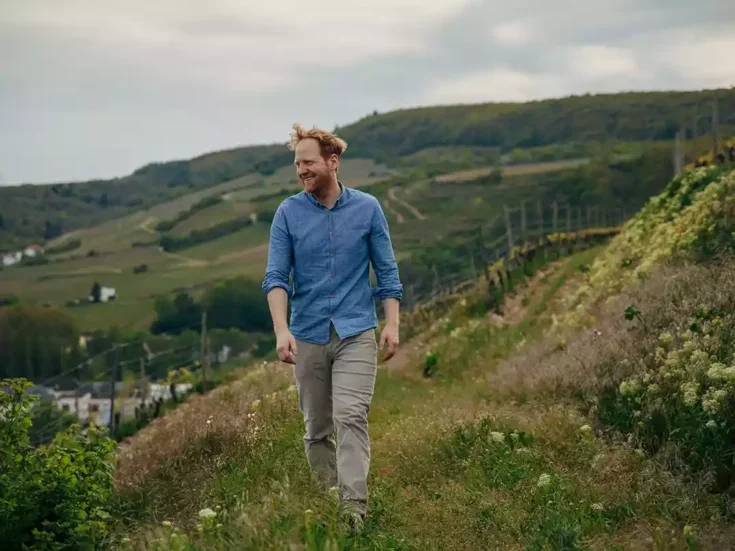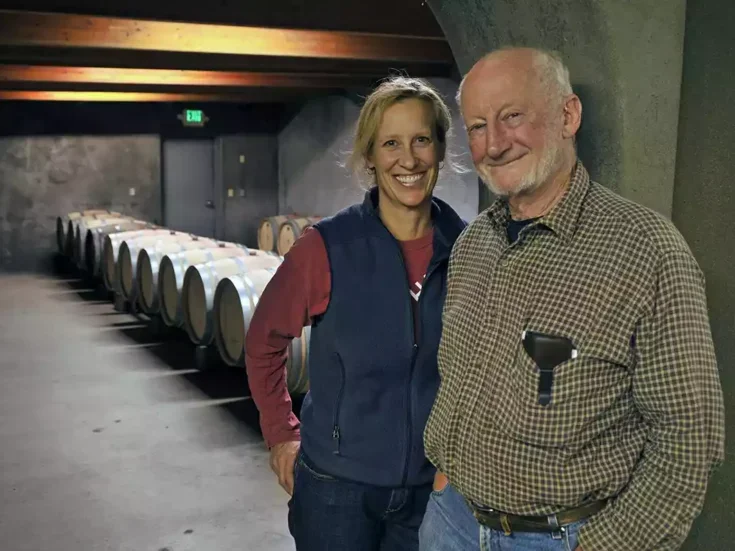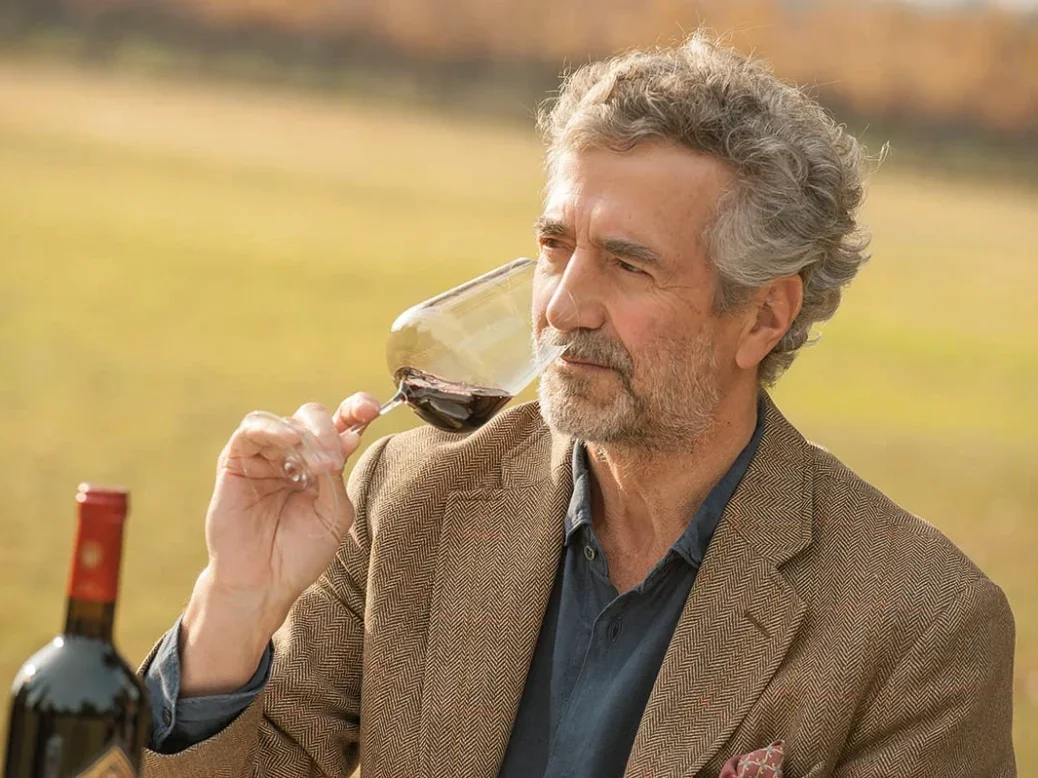
Elin McCoy reports from three days of vertical tastings with Eduardo Chadwick in Chile, discerning the identities and following the progress of Errázuriz Don Maximiano Founder’s Reserve, Seña, and Viñedo Chadwick.
It all began on January 23, 2004, at The Ritz-Carlton in Berlin. Picture a grand room hung with crystal chandeliers, above three dozen international wine professionals seated at long tables for an unusual blind tasting. The lineup included first-growth Bordeaux, a Super-Tuscan, and several Chilean reds from the ambitious, charismatic producer who staged the event: Eduardo Chadwick.
The result was a surprise, a shock, even to Chadwick; two of his icon reds, Viñedo Chadwick 2000 and Seña 2001, emerged as number one and two respectively, beating out the great Château Lafite 2000 and Château Margaux 2001.
Chadwick’s gamble for recognition had paid off, and the taste-off came to be known as the Berlin Tasting, a milestone that upgraded the image of Chilean wines and sprinkled stardust on his own reds. Clearly relishing the memory, he once described that first tasting to me as a “David versus Goliath moment.”
So, when this dynamic, courteous wine visionary invited me to Chile to join a small group of journalists and importers for a celebration of the event’s 20th anniversary in January 2024 and promised vertical tastings of all his icon wines, of course I said yes. Who doesn’t want to take part in a victory lap?
The original Berlin Tasting, Chadwick explained, was inspired by the famous 1976 Judgment of Paris tasting and by watching Robert Mondavi stage similar competitions with his own wines. Back in 2004, Chile’s wine reputation was all about “good value.” English wine critic Tim Atkin MW had called the country “the Volvo of the wine world: dependable but rather boring.” Blind tastings against the world’s benchmarks for quality were the quickest route to establish great wine bona fides and gain international acclaim.
Chadwick took that idea further than just about anyone. Over the following decade he hosted bold reenactments of the Berlin Tasting in nearly 20 major cities around the world: São Paolo (2005); Tokyo and Toronto (2006); Beijing, Seoul, Amsterdam, and Copenhagen (2008); London and Stockholm (2009); New York, Los Angeles, Chicago, Hong Kong, and Budapest (2010); Helsinki and Zurich (2011); Moscow (2012); Dubai, Santiago, Seoul, and São Paulo again (2013).
In Beijing, two of Chadwick’s wines beat out Château Lafite Rothschild, though this in no way weakened China’s Lafite obsession. I attended the one in New York, held on the 36th floor of the Mandarin Oriental hotel, where 65 attendees had their noses in glasses as they looked out over sweeping vistas of the city. The winner, based on our combined final scores, was Chadwick’s 2006 Viña Errázuriz Kai, a Carmenère, followed by 2006 Opus One in second spot and 2006 Haut-Brion in third. My two favorites were different: I put 2006 Lafite in first place, but my second was Chadwick’s 2006 Viña Errázuriz Don Maximiano Founder’s Reserve, a wonderfully balanced Cabernet Sauvignon blend. For number three, I was in line with the majority on Haut-Brion. Yet even when Chadwick’s wines didn’t end up as number one or two, they still gained high-quality shine from holding their own next to the world’s greats—not a bad marketing ploy.
The aim of the 20th anniversary celebration in Chile was different. The three-day extravaganza was an immersion into Chadwick land and how each of their three main icon reds—Errázuriz Don Maximiano Founder’s Reserve, Seña, and Viñedo Chadwick—has evolved since its beginnings.
For a glimpse of the future, we sampled vintages of his more recently added brilliant icon wines from cooler coastal sites in Aconcagua, Errázuriz Las Pizarras Pinot Noir, Chardonnay, and Syrah. We also sipped Chadwick’s sparkling wine, still a work in progress. And we spent time getting to know the next generation: Three of his four charming daughters—Magui, Ale, Pepa, and Mane—are involved in the company.
At each property, a deep dive into soils, vines, and winemaking preceded a formal tasting served up with on-the-spot commentary by the winemakers: Tomás Muñoz of Viña Errázuriz; Emily Faulconer, new technical director of Seña and Viñedo Chadwick; and Francisco Baettig, the longtime winemaker for all of them, who has transitioned to being a consultant.
And over the course of the several days, the vivid, romantic wine backstory of the Errázuriz-Chadwick clan was told in conversations, presentations, and through old sepia-toned photos that hang on the walls of Viña Errazuriz and in the memorabilia rooms at Viñedo Chadwick.
Errázuriz: Terroir and trajectory
Here’s a reminder of how it all began. A European trip inspired wealthy landowner Don Maximiano Errázuriz to establish an eponymous winery in 1870 in the remote paradise of the Aconcagua Valley. He led the expedition on horseback, dug irrigation channels, planted vineyards, and built a winery. His descendant, Eduardo’s father Alfonso, took the family wine fortunes much further, purchasing a 300ha (750-acre) wine estate in the Alto Maipo Valley not far from Santiago. A champion polo player, the captain of Chile’s national team, he laid out his own polo field there.
But politics then intervened. A government land-reform program from 1962 to 1973 forced Alfonso to sell most of their estate and vineyards. The family managed to hang onto the Viña Errázuriz winery and some Aconcagua vineyards until the government grabbed them and it ended up with the bank.
In 1983, Alfonso was able to reclaim control of the now-ruined, cobwebbed winery, and he enlisted the 24-year-old Eduardo to help him build back the family wine fortunes. After a stint studying wine in Bordeaux, Eduardo dreamed of emulating the world’s great wine estates. Ten years later, he was president of Viña Errázuriz and, in 1994, planted the first Syrah vines in Chile.
The country’s first luxury wines appeared in the 1980s, when Chadwick developed Errázuriz’s ultra-premium Don Maximiano Founder’s Reserve, giant Concha y Toro debuted Viña Don Melchor, and Santa Rita, Casa Real. With the 1990s came Almaviva, Clos Apalta, Montes Alpha M, and another Chadwick wine.
The visit of the legendary Robert Mondavi in the early 1990s was another turning point. Soon a joint Mondavi/Chadwick project was in the works: an icon wine they named Seña (meaning sign or signature). It took four years to find the ideal property in Aconcagua, 25 miles (40km) from the Pacific; the first vintage launched in 1997. And when Mondavi lost control of his company to Constellation Brands in 2004, Chadwick quickly purchased the Mondavi share.
In the early 1990s, Eduardo convinced his father to convert his polo field to vines, which became the heart of Viñedo Chadwick, the icon wine created to honor him, which debuted in 2002. The next step was to convince the world that they should pay attention. Chadwick took the challenge as his calling.
What stood out most to me over the days of tasting was how each wine shows off its own distinct personality—which convinced me that terroir matters just as much in Chile as it does elsewhere. For example, Seña, from a cooler site
in Aconcagua than Don Max, is more delicate and silkier in texture.
A second takeaway was how rapidly Chilean winemaking has been changing over the past two decades. The verticals showed a trajectory seen in many other New World countries: a rustic stage learning the ropes, an era of super-ripe fruit and more oak, then new blends of grapes to add complexity and more precise winemaking, and finally wines with less oak that prize more balance, freshness and finesse, and a sense of place.
And finally, how innovative and determined Eduardo Chadwick has been in creating world-class wines in Chile and convincing the world to take them seriously.
Errázuriz Don Maximiano Founder’s Reserve
The serious vertical tastings began on day two, with a morning visit to Viña Errázuriz and a lineup of its rich, flagship red Don Maximiano Founder’s Reserve chosen to illustrate the history of the winery and the grapes on the property. The estate feels like a blend of old and new, past and present, with a traditional whitewashed, tile-roofed winery, as well as a dramatic, circular, modern, energy-efficient one for its high-end wines. The grapes for the cuvée come from the oldest vineyard blocks on the estate’s Aconcagua Valley vineyard: Max I, Max II, and Max V.
The day was sunny and warm, but it was cool in the brick-walled underground cellar where we tasted. The wines, Chadwick says, express a timeline of technological development and ideas about what constitutes a great Chilean red wine. In the beginning, he copied the recipe of Bordeaux. In the 2000s, he admits now, they pushed too far toward an opulent style. Now they pick earlier. The big challenge in warmer years has been learning to manage the evolution of the tannins and preserve balance.
1984
(100% Cabernet Sauvignon; aged 5–7 months in Rauli redwood vats)
This first vintage, says Chadwick, is an early style, before technology, small tanks, the idea of blending, and climate change. The alcohol level is 12.5%. Though impressive for its age, this is more of an emotional experience. Long and direct, it shows intense notes of licorice and lots of acidity. | 90
1990
(100% Cabernet Sauvignon; aged 10 months in French oak, 40% new)
The wine’s savor and spice stand out, and its power and persistence. It’s neither lean nor opulent, and neither Bordeaux nor Napa in style. There’s still an iron tang to the flavors and a bit of lift, but it is past its best, I think. | 88
1995
(95% Cabernet Sauvignon, 5% Cabernet Franc; aged 16 months in new French oak)
A wine that’s very typical of the era: big and tannic, with dark, opulent fruit, plenty of warmth, and apparent oak. “Now I could buy barrels,” explains Chadwick. | 87
2000
(100% Cabernet Sauvignon; aged 18 months in new French oak)
A cool spring and warm, sunny summer, followed by cool weather that delayed harvest. The slow ripening allowed the development of layers of flavor. This is a warm, rich wine that’s aged fairly well. The color is still almost opaque, the tannin sticks out, but the wine has more layers, length, and elegance. | 89
2005
(85% Cabernet Sauvignon, 7% Cabernet Franc, 5% Petit Verdot, 3% Syrah; aged 18 months in new French oak)
My favorite in the flight. It’s the first vintage to play with a blend of grapes. With dark, intense aromas of black fruit, flavor notes of minerals, pepper, and spice, and a powerful, tannic structure, it seems to be casting about for a new style. | 90+
2011
(75% Cabernet Sauvignon, 10% Carmenère, 10% Petit Verdot, 5% Malbec; aged 22 months in French oak, 85% new)
Starting in 2010, Baettig started dialing back on oak and ripeness, with a huge shift in style. This vintage was cool, with a late harvest. The textbook pencil-shavings aroma and expressive red-fruit flavors signal the shift to more freshness. | 91+
2013
(79% Cabernet Sauvignon, 10% Malbec, 6% Carmenère, 5% Petit Verdot; aged 22 months in French oak, 65% new)
A superb, cold growing season produced wines with intense fruit and freshness. Mineral-toned, dark and deep, this wine benefits from more Malbec, which, Muñoz says, gives a floral element. But despite its power and balance, I found this vintage a bit disjointed right now. | 92
2015
(67% Cabernet Sauvignon, 15% Carmenère, 8% Malbec, 7% Petit Verdot, 3% Cabernet Franc; aged 22 months in French oak, 63% new)
A dry, warm growing season gave perfectly ripe fruit, and Baettig harvested earlier than he might have in the past to preserve freshness and intensity. The nose is deep and rich, a combo of plummy fruit, crushed nuts, and coffee, and the flavors match, with a hint of orange peel in the background. The texture is dense and velvety. | 93
2018
(70% Cabernet Sauvignon, 15% Malbec, 7% Carmenère, 5% Petit Verdot, 3% Cabernet Franc; aged 22 months in French oak, 65% new)
Baettig considers 2018 “a perfect vintage,” with all conditions aligned to best express the terroir in the Don Maximiano vineyards. It was my top wine of this tasting lineup, with a nose of violets, layers of juicy cranberry and raspberry flavors, poise and balance, and a deliciously smooth texture, though not as velvety as 2015. | 94+
2021
(63% Cabernet Sauvignon, 22% Malbec, 8% Carmenère, 7% Petit Verdot; aged 22 months in French oak, 70% new)
Another moderately cool season with long, slow ripening. What struck me was the brilliant dark ruby color charged with light, the expressive floral, blueberry fruit, spice, and mineral nose, the licorice flavor notes, and the very silky texture. | 92
Seña
After lunch on the patio, we headed to the Seña hillside vineyard in the middle of the valley, 25 miles (40km) from the Pacific, which was converted to biodynamic farming by the famous Alan York in 2005. A soil pit shows us how rocky the vineyard is. I did not climb into it.
The original model for Seña was a classic Bordeaux-style red blend with “Chilean soul,” meaning the addition of Carmenère. The three flights (plus the two additional vintages served at dinner) showed how much the wine changed after many trials and experiments.
The quality of Merlot proved inconsistent, so it was replaced with larger and larger proportions of Malbec, and the cuvée gained complexity, balance, and elegance. Reducing the amount of new oak helped, too. To me, Seña has found its ideal style in recent vintages, the best yet, with more aromatic complexity and greater precision and purity of fruit, especially in the 2021. The winemaker for the first four vintages was Tim Mondavi; Errázuriz winemaker Francisco Baettig made most of the others.
The setting was the Hilltop Mirador, where we tasted under a cloudless, hard-blue afternoon sky, with stunning views of undulating rows of vines, and then dined at tables with tiny vases of flowers.
2021 Rocas de Seña
Only the second vintage of Seña’s second wine. Made from younger vines, it’s also a different blend, with six varieties—Malbec (35%), Syrah (21%), Cabernet Sauvignon (20%), Grenache (10%), Petit Verdot (9%), and Mourvèdre (5%). It’s aged in less new oak and has a bright, fresh, juicy, easy-to-drink personality. Think layers of savory pomegranate and sour-cherry fruit. | 93
1995 Seña (with dinner)
(70% Cabernet Sauvignon, 30% Carmenère)
We drank the first vintage of Seña with wood-grilled lamb cooked for five hours. The pairing was perfect. The leather and dried-herb and flower scents, and the flavors of the wine, echoed the smoky/savory flavors of the lamb and the spicy Chilean merquén seasoning of the potatoes. | 90
1996 Seña
(91% Cabernet Sauvignon, 9% Carmenère; aged 15 months in new French oak)
The first commercial release, from a cooler-than-normal growing season, harvested early. Garnet color with a browning edge, a minty, eucalyptus bouquet, and intense soft, savory flavors of herbs. It’s an older style of Chilean Cabernet, soft, with marked acidity and a core of warm fruit. | 92
1998 Seña (90% Cabernet Sauvignon, 5% Carmenère, 5% Merlot; aged 18 months in French oak, 92% new)
This was an El Niño vintage, with a cold, rainy winter and spring that led to a late harvest—the Cabernet wasn’t harvested until April. Mouth-filling, spicy, and persistent, with a plush core of fruit and a chaparral character of dried herbs like sage, and hints of tobacco. | 91
2002 Seña (70% Cabernet Sauvignon, 20% Merlot, 10% Carmenère; aged 18 months in French oak, 100% new)
Another cool year that delayed harvest to the end of April. The wine isn’t big or powerful but has a seamless, savory character, with a flowing texture and enough concentration to age more. It’s distinctive, resembling a Super-Tuscan more than a Bordeaux. | 91
2008 Seña
(57% Cabernet Sauvignon, 20% Carmenère, 10% Merlot, 8% Petit Verdot, 5% Cabernet Franc; aged 22 months in French oak, 100% new)
The dramatic change in the blend signals a new era of looking for more balance, with winemaker Francisco Baettig in charge. It’s more elegant and complex than previous vintages, with a nose of violets and baking spices, a taste of juicy cherries and berries, and a hint of tobacco in the finish. You feel the oak, though. This comes from a very cool spring and long, dry growing season. | 92
2009 Seña (54% Cabernet Sauvignon, 21% Carmenère, 16% Merlot, 6% Petit Verdot, 3% Cabernet Franc; aged 22 months in French oak, 100% new)
Dense, powerful, rich, and concentrated, with focused scents, a silky texture, and warm balsamic notes. The hot, dry, early season also meant the Carmenère was perfectly ripe. It shows off the older, riper style popular at the time. | 90
2011 Seña (58% Cabernet Sauvignon, 15% Carmenère, 15% Merlot, 7% Petit Verdot, 5% Cabernet Franc; aged 22 months in French oak, 75% new)
Another cool, late-ripening season produced a wine that’s vibrant, still fresh, and savory, with more focus and clarity, as well as dried-herb and spice aromas, mint and red-fruit flavors, and an elegant structure. The lower level of new oak is a plus. My favorite wine in the second flight. | 93+
2015 Seña (57% Cabernet Sauvignon, 21% Carmenère, 12% Malbec, 7% Petit Verdot, 3% Cabernet Franc; aged 22 months, 88% in French oak barrels, 66% new, 12% in foudres)
This dark, almost opaque wine from a moderately warm vintage has a lush, ripe fruit nose with notes of cedar, herbs, and just-opened flowers, but it was overshadowed by the stunning 2018 and 2021 in the same flight. Swapping Merlot for Malbec shifts the wine’s character for the better, and it brims with complex mint and olive flavors. | 94
2016 Seña (with dinner)
(55% Cabernet Sauvignon, 20% Malbec, 12% Petit Verdot, 8% Carmenère, 5% Cabernet Franc; aged 22 months, 88% in French oak barrels, 73% new, 12% in foudres)
We drank this with dinner, and I was surprised that such a stylish, elegant red went so well with king crab and avocado sauce. It worked because the wine is juicy yet graceful, with freshness and energy and the taste of sour cherries, an iron tang, and spice. This is from a cool year with record rainfall in April. | 96
2018 Seña (55% Cabernet Sauvignon, 18% Malbec, 15% Carmenère, 7% Cabernet Franc, 5% Petit Verdot; aged 22 months, 85% in new French oak barrels, 15% in foudres)
I loved this polished, rich, concentrated wine with cedary aromas and layers of enticing red-fruit flavors. It has density, succulence, purity, length, and refinement, plus a perfect balance between power and elegance. This was a great vintage for Chilean reds and, along with the 2021, was my top wine of this tasting. | 97
2020 Seña
(53% Cabernet Sauvignon, 25% Malbec, 15% Carmenère, 7% Petit Verdot; aged 22 months, 90% in French oak barrels, 78% new, 10% in foudres)
This resembles the 2018, and Chadwick says this confident style is the direction of the future. The wine is expressive right now, with refreshing acidity, lifted complex flavors, a silky texture, and a persistent finish. Though it’s dense, rich and powerful, and from a warm vintage, it also has super balance, with alcohol at 13.5%. | 96
2021 Seña (50% Cabernet Sauvignon, 27% Malbec, 17% Carmenère, 6% Petit Verdot; aged 22 months, 90% in French oak barrels, 70% new, 10% in foudres)
The gorgeous aromas and flavors seem to say, “You must drink another glass.” Lots of focus, with purity of fruit, firm tannins, polish, and lift. | 97
Viñedo Chadwick
On day three, we visited the historic Chadwick home in Puente Alto, Maipo Valley, where Eduardo Chadwick and his family once lived. Today it’s no longer a residence, instead dedicated to history and entertaining. After admiring the polo-field-turned-vineyard and the artifacts and photos in a Polo Room dedicated to Alfonso Chadwick’s favorite career, we moved to the Berlin Tasting Room and settled into the tasting at a long table in a light-filled area. We drank other vintages with a three-course lunch on the shady patio outside. The ten-vintage vertical tasting was poured in two flights of five wines, with three more over lunch.
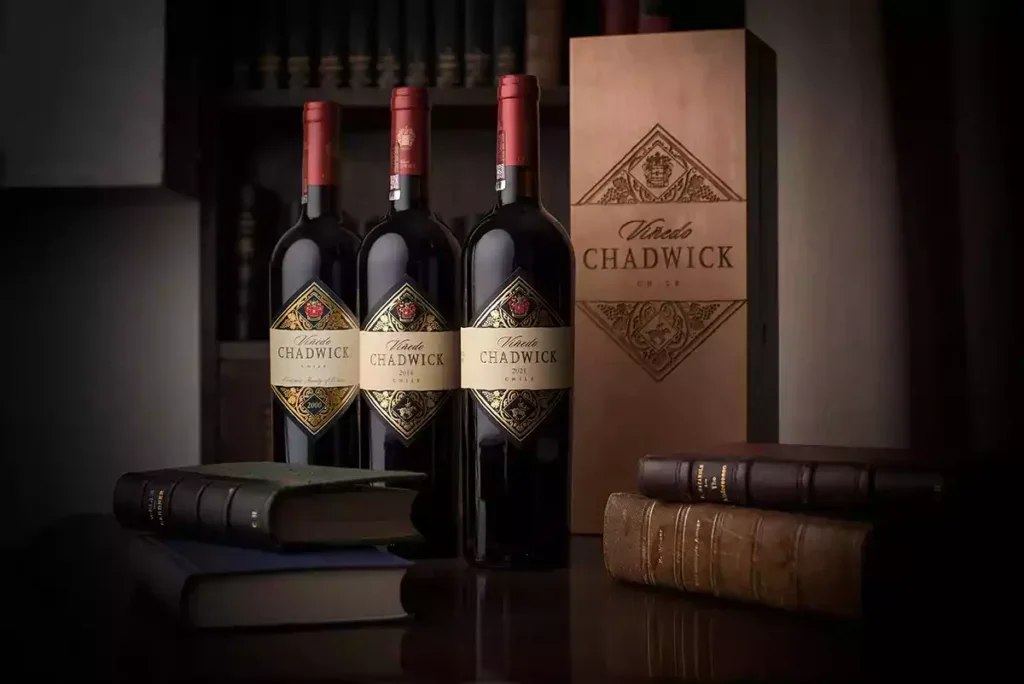
1999
(94% Cabernet Sauvignon, 6% Carmenère; aged 18 months in new French oak)
The inaugural vintage, the only one with Carmenère, comes from a very warm vintage with very reduced yields, harvested a couple of weeks earlier than was typical. It’s big and powerful still, with plenty of ripe, round fruit, a strong structure, and licorice and herb notes. While it still has elegance and finesse, it feels old-fashioned. | 91
2000 (at lunch) (100% Cabernet Sauvignon; aged 17 months in new French oak)
This was the wine that came number one at the first Berlin Tasting, so ending our lunch at Viñedo Chadwick with Chilean cheese and this vintage was a great treat. From a cool year, it’s a wine with complex aromas and intense flavors, with a firm, still evolving structure. | 93
2001
(100% Cabernet Sauvignon; aged 18 months in new French oak)
A cool slow-ripening vintage that required leaf-pulling for grapes to ripen fully. In the nose, I found hints of mint, cedar, and dried flowers—and a core of rich dark concentrated fruit in the taste. It’s polished and still concentrated. | 92+
2006
(100% Cabernet Sauvignon; aged 18 months in new French oak)
Another cool, slow-ripening year that resulted in this very balanced, bright, cassis-scented wine with a deep, vertical character. The rich, dense flavors remind me of dark chocolate and tobacco. It’s big, in the style of the time, with fine tannins and a silky texture. | 91+
2008 (at lunch)
(97% Cabernet Sauvignon, 3% Merlot; aged 22 months in new French oak)
The year was dry and hot, and the wine is ripe and complex, with plenty of freshness, though it has an old-style feel. A fine partner to duck confit and orange sauce. | 94
2010
(100% Cabernet Sauvignon; aged 22 months in 95% new French oak)
In a cooler than average year, this reflects a new push toward more finesse and harmony. It’s very perky, minty and fresh, with layers of ripe red fruit and cocoa powder. Despite finer tannins, expressive deep flavors, and a very long finish, it seems a bit alcoholic. | 92
2012
(100% Cabernet Sauvignon; aged 22 months in 90% new French oak)
Deep, powerful, and warm-toned, this soft-textured wine comes from a warm vintage with low yields. The nose is quite complex, a mix of deep, bright raspberry and cherry notes, tobacco and truffles, with flavors to match. It’s more bone than flesh. My favorite in the first flight. | 93
2014
(100% Cabernet Sauvignon; aged 22 months in 75% new French oak)
An exceptional vintage for this wine, which received Chile’s first 100-point rating. It shows a clear change in style, in the direction of more freshness, precision, purity, and balance. The growing season was cool, with even ripening and an early harvest. Yields were so low that only 400 cases were made. With vivid color and aromas—with a hint of mint—this seductive, linear, and structured red has super-fine tannins, dark fruit, and plenty of complexity. 13.5% ABV. | 95
2015
(100% Cabernet Sauvignon; aged 22 months in French oak barrels, 75% new, a proportion in foudres)
A warm, not hot, vintage that was very good for Chile. The wine isn’t as dark and dense as 2014, but it’s riper tasting and more powerful, with some mint and cedar aroma notes and fruit, herb, tobacco, and chocolate elements in the taste. I found almost a candied quality. | 94+
2016 (at lunch) (97% Cabernet Sauvignon, 3% Petit Verdot; aged 22 months, 80% in new French oak barrels, 20% in foudres)
A classical Maipo Cabernet, it’s super-elegant and complex, with harmonious tannins, excellent structure, and surprisingly low in alcohol—13%. A winner. | 96
2017
(96% Cabernet Sauvignon, 4% Petit Verdot; aged 22 months, 80% in new French oak barrels, 20% in foudres)
The earliest harvest ever recorded at Viñedo Chadwick, thanks to a torridly hot growing season. Francisco Baettig says it was “a big-challenge vintage” that showed they could cope with heat, which will be more and more important given climate change. The solution was picking early, one month before they did in 2016. You wouldn’t guess the heat issue from this intense, rich wine, which has bright, subtle, savory, bay-leaf aromas and deep flavors. | 94+
2018
(97% Cabernet Sauvignon, 3% Petit Verdot; aged 22 months, 80% in new French oak barrels, 20% in foudres)
One of my two favorites of the flight, with the 2021, this exceptional vintage represents another step up in firmly establishing the wine’s identity. Lifted, juicy cherries and chocolate aromas, perfect balance, and a long finish with a fantail of gorgeous flavors; it also has power and poise and finesse. A wine that Francisco Baettig loves. | 98
2021
(97% Cabernet Sauvignon, 3% Petit Verdot; aged 22 months, 80% in new French oak barrels, 20% in foudres)
The cool growing season provided a chance for long, even, gentle ripening that translates into great elegance in the wine. What stands out are the wine’s lively energy, floral aromas, very pure, precise fruit, and long, mineral finish. One participant, American writer Karen MacNeil, called the wine “a horse to bet on.” Like 2018, it has exceptional balance, a luxurious texture, and dark-toned tannins. | 98

